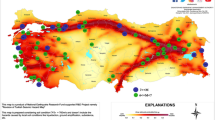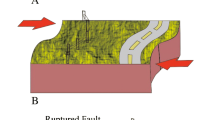Abstract
This paper investigates the performance of grid and mat foundations under two- and five-storey buildings in an earthquake loading. A detailed study was conducted on a defined area in a northern region of Iran where the ground is covered with thick soft fine-grained soil strata with a potential of cyclic softening. Overall, the observed behavior shows better performance of the grid foundation modeled in this study. Its performance exceeds in its bearing capacity, which is higher than that of the mat foundation with the same size. The relative vertical displacement of the corners of the grid foundation is almost the same or even less than that of the mat foundation after an earthquake. On the contrary, the total average displacement of the mat foundation is larger than that of the grid foundation. Further, there is concentration of stresses in local areas at sides in the mat foundation, in contrast to grid foundation, in which a nearly uniform distribution of stress is observed all over the foundation., Taken together, the structure of the grid foundation employs its capacity nearly fully, making it a more economical option in comparison to the mat foundation of the same size. Based on findings from this study, consideration of grid foundation as an alternative of mat foundation is recommended.

















Similar content being viewed by others
Availability of Data and Materials
Not applicable to this paper.
Code Availability
Not applicable to this paper.
References
American Society of Civil Engineers, and Structural Engineering Institute (2016) Minimum design loads on buildings and other structures. Standards Committee
ASTM D-2487 (2017) Standard practice for classification of soils for engineering purposes (Unified Soil Classification System). ASTM International
Atkinson JH, Bransby PL (1978) The mechanics of soils: an introduction to critical state soil mechanics. McGraw-Hill, New York
Banerjee R, Sengupta A, Reddy GR (2019) Study of a surface raft foundation in dry cohesionless soil subjected to dynamic loading. Curr Sci 117(11):1800–1812
Boulanger RW, Idriss IM (2007) Evaluation of cyclic softening in silts and clays. J Geotech Geoenviron Eng 133(6):641–652
Bowles JE (1996) Foundation analysis and design, 5th edn. McGraw-Hill Companies, New York
Brinkgreve RBJ, Kappert MH and Bonnier PG (2007) Hysteretic damping in a small-strain stiffness model. In: Proceedings of the numerical modeling in geomechanics, NUMOG X, Rhodes, pp 737–742
Brinkgreve RBJ, Swolfs WM and Engin E (2020) PLAXIS user’s manuals. PLAXIS BV The Netherlands: Delft.
Chang DW, Lien HW, Wang T (2018) Finite difference analysis of vertically loaded raft foundation based on the plate theory with boundary concern. J GeoEng 13(3):135–147
Chang DW, Lu CW, Tu YJ, Cheng SH (2022) Settlements and subgrade reactions of surface raft foundations subjected to vertically uniform load. Appl Sci 12(11):5484
Coduto DP, Kitch WA, Yeung MCR (2014) Foundation design: principles and practices. Prentice Hall, Saddle River
Davarci B, Ornek M, Turedi Y (2014) Analyses of multi-edge footings rested on loose and dense sand. Periodica Polytech Civ Eng 58(4):355–370
Day RW (2010) Foundation engineering handbook: design and construction with the 2009 international building code. McGraw-Hill Education, New York
Fakher A (2011) Advanced foundation engineering, 1st edn. University of Tehran Press (in Persian)
Ghazavi M, Hadiani N (2005) Bearing capacity of multi-edge shallow foundations. M.Sc. thesis, K. N. T. University of Technology, College of engineering, Tehran, Iran (in Persian)
Ghazavi M, Mokhtari S (2008) Numerical investigation of load-settlement characteristics of multi-edge shallow foundations. In: Proceedings of the 12th international conference of international association for computer methods and advances in geomechanics, Goa, India, pp 3344–3351
Hodgkinson A (1986) Foundation design. Architectural Press, Oxford
Ibrahim A, Dif A, Othman W (2018) Nonlinearity analysis in studying shallow grid foundation. Alex Eng J 57(2):859–866
Iranian National Building Code, 7th issue (2013) Foundation Design and Construction. Tehran, Road, Housing and Urban Development Research Center
Jalili J, Askari F, Haghshenas E, Marghaiezadeh A (2023) Investigation on economical method of foundation construction on soft soils in seismic zones: a case study in southern Iran. Geomech Eng 32(2):209
Li L, Pan R, Lu Y (2022) Seismic response sensitivity analysis of the raft foundation NPP reactor building under different site conditions. Energies 15(19):7135
Lysmer J, Kuhlemeyer RL (1969) Finite dynamic model for infinite media. J Eng Mech Div 95(4):859–877
Petalas A, Galavi V (2013) PLAXIS liquefaction model UBC3D-PLM. PLAXIS Report
Poulos HG (2017) Tall building foundation design. CRC Press, London
SakhtAzma Geotechnical Consulting Engineers (2019) Report of subsurface investigation-Aq Qala, Golestan, Iran
Tabsh S, El-Emam M, Partazian P (2020) Numerically based parametric analysis of mat foundations. Pract Period Struct Des Constr 25(2):04020009
Seed RB, Cetin KO, Moss RE, Kammerer AM, Wu J, Pestana JM, Riemer MF, Sancio RB, Bray JD, Kayen RE and Faris A (2003) Recent advances in soil liquefaction engineering: a unified and consistent framework. In: Proceedings of the 26th Annual ASCE Los Angeles Geotechnical Spring Seminar, Long Beach, CA.
Tjie Liong G (2014) Common mistakes on the application of PLAXIS 2D in analyzing excavation problems. Int J Appl Eng Res 9(21):8291–8311
Van Baars S (2016) 100-year Prandtl’s Wedge-intermediate Report, University of Luxembourg.
Yeganeh N, Fatahi B (2019) Effects of choice of soil constitutive model on seismic performance of moment-resisting frames experiencing foundation rocking subjected to near-field earthquakes. Soil Dyn Earthq Eng 121:442–459
Yu Y, Damians IP, Bathurst RJ (2015) Influence of choice of FLAC and PLAXIS interface models on reinforced soil–structure interactions. Comput Geotech 65:164–174
Acknowledgements
This study was supported partly by the International Institute of Earthquake Engineering and Seismology (IIEES) and partly by the Natural Disasters Research Institute (NDRI). The authors gratefully acknowledge the IIEES and NDRI as well as Dr. Moosavi, Dr. Haghshenas and Mrs. Rakhshande for the valuable data they gathered from the field observations. The authors also thank Mr. M. Asgari, Mr. G. Hadavi and Mr. S. Azadmanesh for their assistance in conducting the tests.
Funding
This study was supported partly by the International Institute of Earthquake Engineering and Seismology and partly by the Natural Disasters Research Institute.
Author information
Authors and Affiliations
Corresponding author
Ethics declarations
Conflict of interest
Not applicable to this paper.
Additional information
Publisher's Note
Springer Nature remains neutral with regard to jurisdictional claims in published maps and institutional affiliations.
Rights and permissions
Springer Nature or its licensor (e.g. a society or other partner) holds exclusive rights to this article under a publishing agreement with the author(s) or other rightsholder(s); author self-archiving of the accepted manuscript version of this article is solely governed by the terms of such publishing agreement and applicable law.
About this article
Cite this article
Jalili, J., Askari, F. & Marghaiezadeh, A. Grid Versus Mat Foundations in Areas of High Seismicity: A Case Study in Northern Iran. Geotech Geol Eng 41, 3427–3446 (2023). https://doi.org/10.1007/s10706-023-02466-w
Received:
Accepted:
Published:
Issue Date:
DOI: https://doi.org/10.1007/s10706-023-02466-w




